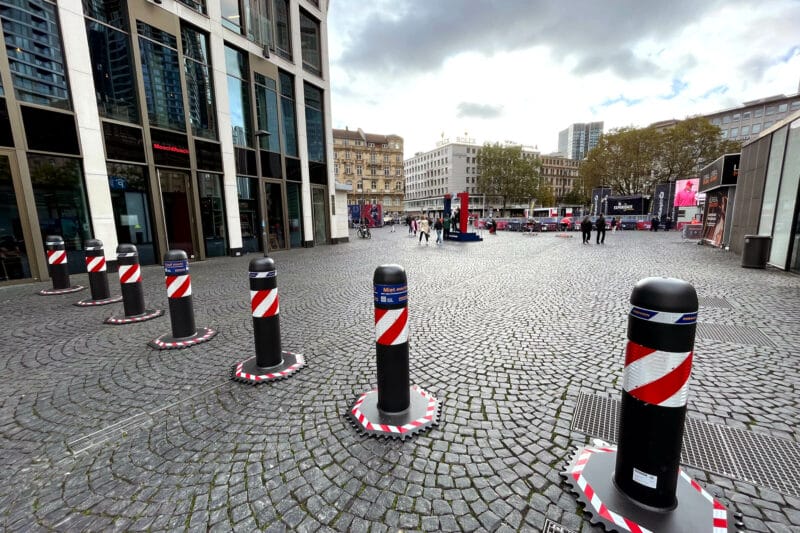Certified & tested
We only offer you tested and certified vehicle safety barriers. Our access barriers meet the various requirements of the international crash test standards.

Certified personal protection
ASTM F2656
Certification
ASTM International (American Society for Testing and Materials) is an organisation based in the USA that sets standards for goods and services. Its test standards F2656/2656M-20 relate to the field of physical safety products, e.g. vehicle safety barriers, access barriers, safety gates, etc. The crash test is usually carried out with the following vehicle classes and parameters:
- Car of 1100 kg
- Pick-up of 2270 kg
- Truck of 6800 kg (American design)
- Truck of 7200 kg (European design)
- The impact speeds are 50 km/h | 65 km/h | 80 km/h
- Angle of impact 90°
The vehicle penetration depth is divided into three categories (P1: 1m | P2: 7m | P3: 30m). This is measured from the back of the access barrier facing away from the impact to the reference point on the test vehicle. The fragment that ends up furthest away is documented (flying debris).
DIN SPEC 91414-1
Certification
DIN SPEC 91414 is a German specification that defines the requirements, test methods and performance criteria for mobile vehicle safety barriers. These barriers are intended to protect public spaces from vehicle impacts and terrorist attacks. The specification came out of the project “Development of approval criteria for mobile vehicle barriers for safeguarding public space against vehicle impacts” and is part of the “Protection of public spaces” initiative funded by the German Federal Ministry of the Interior, Construction and Community (BMI). DIN SPEC 91414-1 comprises three main tests: impact test, displacement test and manipulation test.
ISO 22343-1
Certification
ISO 22343 is an international standard that was introduced in September 2023 and replaces the previous standards IWA 14-1 and PAS 68. This standard specifies how vehicle safety barriers (such as bollards, barriers and road blocks) should be tested for resistance to vehicle collisions. The main changes under ISO 22343 comprise:
- New vehicle classifications: Updated descriptions and additional weight classes for vehicles.
- Stricter fault conditions: Specification of conditions for excessive penetration of vehicles and displacement after an impact.
- Extended vehicle age class: Inclusion of a larger age range for vehicles in tests.
- Lower debris weight: Adjustment of the permitted weight of flying debris from 25 kg to 2 kg.
These updates are designed to improve the accuracy and applicability of the tests, which makes it easier for manufacturers to demonstrate the conformity of their products and allows users to compare the effectiveness of various HVM products.
Technical guidelines German police
Certification
Technical guidelines German police (TR) were developed in 2018 by the Police Technical Institute of the German Police University (PTI) and describe the special requirements for mobile police security barriers. This test procedure was created exclusively for mobile security barriers. The TR distinguish between three protection classes (SK1, SK2 and SK2+). In each protection class, a distinction is made between a paved and an unpaved surface. A truck with a test weight of 7,500 kg, a truck with a test weight of 12,000 kg or a truck with a test weight of 30,000 kg can be used for the test. Depending on the protection class and truck selected, the impact speeds are 53 km/h or 42 km/h (SK1), 83 km/h or 66 km/h (SK2) and ≥ 73 km/h or ≥ 46 km/h (SK2+). The penetration depth is measured from the point of impact to the maximum penetration depth of any part ≥ 100 kg. Fragments weighting 2 kg or more are documented. For full certification, a test with both a 90° and a 45° angle of impact must be carried out.
IWA 14-1
Certification
IWA withdrawn since September 2023*
was published in 2013 to provide an internationally recognised standard that could be applied consistently. This test procedure assesses the performance of barriers on the basis of various test vehicles (cars with a test weight of 1,500 kg to trucks with a test weight of 30,000 kg). Impact speeds commonly tested are 48 km/h, 64 km/h and 80 km/h. The angle of impact is usually 90°. The penetration is measured from the front of the barrier on the impact side to the datum point (reference point on the vehicle). Fragments weighing 25 kg or more are documented.
*Withdrawn means that the manufacturer can no longer test to its standards, therefore no further IWA certifications will be given out. This however does not affect the validity of the existing certification.
PAS-68
Certification
PAS 68 - withdrawn since September 2023
was first published in 2005 and has since been replaced by the 2013 version. This test procedure allows the certification of barriers such as road blocks, conventional barriers and high security gates and is based on a classification of six types of test vehicles (cars with a test weight of 1,500 kg up to trucks with a test weight of 32,000 kg). The most common impact speeds tested are 48 km/h, 64 km/h and 80 km/h. The angle of impact is usually 90°. The penetration is measured from the back of the barrier on the opposite side to the impact to the datum point (reference point on the vehicle). Fragments weighing 25 kg or more are documented.
*Withdrawn means that the manufacturer can no longer test to its standards, therefore no further IWA certifications will be given out. This however does not affect the validity of the existing certification.
